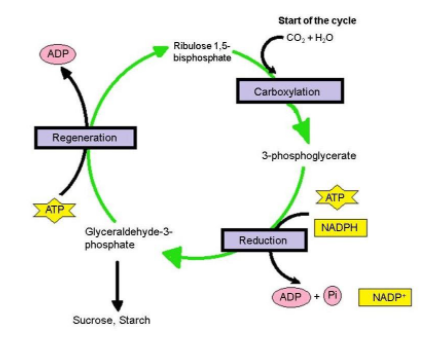Question
Question: Define carbon fixation in plants. What was the contribution of Melvin Calvin? Describe the three pha...
Define carbon fixation in plants. What was the contribution of Melvin Calvin? Describe the three phases of Calvin cycle.
Solution
This is the process by which plants convert light energy into chemical energy. Utilization of CO2 takes place during this process.
Complete Answer:
Autotrophic organisms have the capability to transform atmospheric CO2 to a reduced state i.e. carbohydrate and, this process is known as carbon fixation or carbon assimilation. All the photosynthetic eukaryotes, from the most primitive alga to the most advanced angiosperm, reduce CO2 to carbohydrate through the same basic mechanism.
Contribution of Melvin Calvin: The complete biosynthetic pathway of photosynthetic carbon reduction cycle was for the first time elucidated by Melvin Calvin in and his colleagues in the 1950s that is why it is called the Calvin cycle. He inserted the radioactively labelled carbon (14C) into photosynthetic algae and analysed the pathway of carbon fixation in the plant by the method of two-dimensional paper chromatography. For this work he was awarded the Nobel Prize in 1961. He discovered that the first stable product formed during the process of carbon fixation is a 3-carbon organic acid, namely, 3-phosphoglyceric acid (PGA). Thus, it is also called the C3 cycle.
Three phases of Calvin cycle: The Calvin cycle proceeds in three stages –
1. Carboxylation: In this stage CO2 and water from the environment enzymatically combine with a 5-carbon compound, Ribulose-1, 5-bisphosphate (RuBP), and generates two molecules of a 3-carbon intermediate, 3- phosphoglycerate which is the first stable compound of the Calvin cycle.
2. Reduction: In this stage, 3-phosphoglycerate is reduced to glyceraldehyde-3-phosphate (a carbohydrate) by the use of ATP and NADPH which are produced during light reaction.
3. Regeneration: The cycle is completed by the regeneration of ribulose-1,5-bisphosphate from glyceraldehyde-3-phosphate. Ribulose-1, 5-bisphosphate is the CO2 acceptor.

Note: The C4 photosynthetic carbon assimilation cycle and the photorespiratory carbon oxidation cycle (C2 cycle) are either supplementary to or dependent on the basic C3 cycle.
